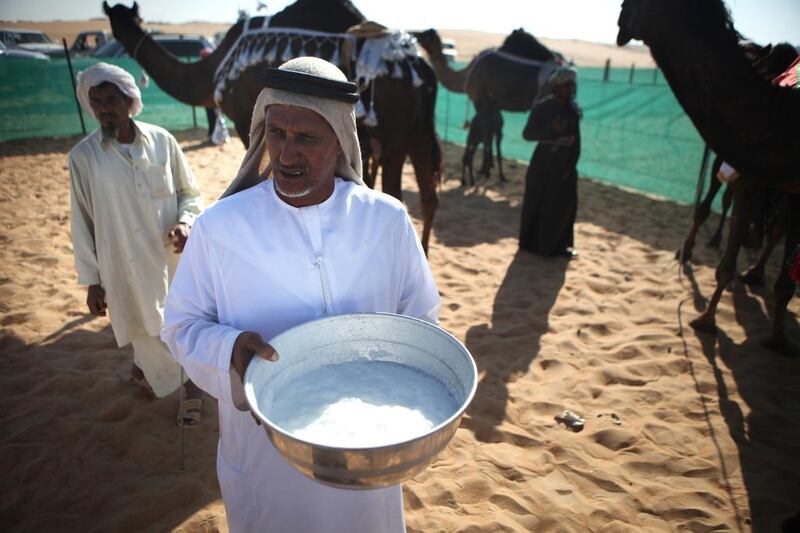Camels have long been a valued part of Middle Eastern culture thanks to their hardiness and, in particular, their ability to remain active even when little water is available.
In conditions that would defeat creatures such as horses, tough-as-old-boots camels can just keep on going.
But the value they have brought to humankind has, for a long time, extended beyond lugging around loads and carrying people from place to place.
Their milk has been drunk by people since as far back as 5,000 years ago and, thanks to its ready availability in supermarkets here, many UAE residents enjoy a glass or two with their meals.
Those who drank camel milk in past millennia were onto a good thing, because modern-day science has shed light on a host of health benefits associated with its consumption.
Many of these are detailed in a recent review article in the Emirates Journal of Food and Agriculture, entitled Therapeutic Potential of Camel Milk, by researchers from India’s Birla Institute of Technology and Science Pilani (BITS Pilani). The involvement of scientists from India is appropriate because, just as camel milk has long been a favourite in the Gulf region, so it is drunk by some traditional communities in South Asia.
One of the key illnesses camel milk has been shown to be effective against is diabetes, a particular problem in the Gulf because of poor diets and sedentary lifestyles.
Camel milk has been shown, said the review’s senior author, Dr Uma S Dubey, of BITS Pilani’s Rajasthan campus, to be effective in reducing the level of glycosylated or glycated haemoglobin in the blood. This is haemoglobin to which glucose is attached, and is typically found at high levels in people with diabetes. Camel milk can therefore be used to reduce the dose of insulin that diabetes patients require.
“This is because camel milk has been shown to contain an insulin-like molecule,” said Dr Dubey.
“Diabetes is a disease in which the therapeutic potential of camel milk can be maximally utilised. It has well-observed clinical benefits.”
It is no wonder then that, as the authors of the review note, epidemiological surveys indicate that there is a low prevalence of diabetes in communities where camel milk is consumed.
Another important issue concerns the immune system. Human milk contains a variety of immunological substances that can help to protect babies from infection, with studies showing that a breast-fed baby can receive up to 1g of the main type of antibody in human milk, secretory immunoglobulin A, each day.
Camel milk, too, contains large quantities of antibodies that, similarly, can help to protect against infection. Enzymes it contains, such as lysozyme and lactoperoxidase, are likely to help combat bacterial infections.
There are also dietary reasons why drinking camel milk makes sense. It has a high concentration of unsaturated fatty acids, such as oleic acid, a monounsaturated fatty acid that can lower the concentration in the blood of harmful forms of cholesterol. Camel milk is also high in mineral content and contains significant amounts of certain types of vitamins. It has also been shown to reduce lactose intolerance, combat hepatitis and decrease kidney and liver damage due to alcohol.
So it is no wonder that Dr Dubey “certainly” recommends that people regularly drink camel milk to maintain good health, although she cautions that unpasteurised “pooled milk” from multiple camels could pose health risks because of unidentified microbes.
“Fresh milk from a healthy camel undoubtedly has multiple nutritional and health benefits,” she said.
However, camel milk is, as of now, perhaps being underutilised as a therapeutic agent. Dr Dubey notes that, in terms of its medical benefits, it is typically used “only at a local level and on the basis of traditional knowledge”.
More research is needed to harness these medical applications, with cancer treatment one area where it could be used in future. As Dr Dubey says, the presence of a specific anti-cancer molecule in camel milk has not yet been established, but camel milk has been shown to lyse, or destroy, cancer cell lines. It is thought that it does this by interfering with transcription, the process in which DNA is converted into RNA, which in turn forms proteins.
The authors of the review, who also include Manohar Lal and Anyaa Mittal, from the BITS Pilani Rajasthan campus, and Suman Kapur, from the BITS Pilani Andhra Pradesh campus, suggest that camel milk could contain a substance with the complex-sounding name of camel alpha-lactalbumin made lethal to tumour cells, or CAMLET.
The milk of most types of mammals contains alpha-lactalbumin as the main protein, and a study from two decades ago found that, when isolated from human milk, this substance could destroy cancer cells. A later piece of research found that it did this when in a complex with oleic acid, leading to the name human alpha-lactalbumin made lethal to tumour cells, or HAMLET.
More recently, a similar anti-cancer effect has been seen with alpha-lactalbumin from bovine (cow’s) milk, again when associated with oleic acid, resulting in the acronym BAMLET.
Molecules such as these are often found in common between species that are closely related in evolutionary terms, so the existence of BAMLET, coupled with the demonstrated anti-cancer properties of camel milk, strongly indicates that something similar is found in camel milk.
“It would be in the best interest of patients if any anti-cancer molecule could be isolated or derived from camel milk,” said Dr Dubey.
So, as modern science discovers more about the therapeutic benefits of camel milk, specific components could be used in a more targeted ways to combat illness. It is an outcome that, were they to have known, would probably have pleased those who began drinking this precious liquid all those thousands of years ago.
newsdesk@thenational.ae
Daniel Bardsley is a UK-based freelance journalist and former reporter at The National.







